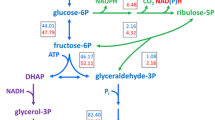Abstract
To increase ethanol yield and decrease glycerol production in Saccharomyces cerevisiae, the strategies of direct cofactor-regulation were explored. During anaerobic batch fermentations, the yeast expressing Bacillus cereus gapN gene, encoding non-phosphorylating NADP+-dependent glyceraldehyde-3-phosphate dehydrognease, produced 73.8 g ethanol l−1, corresponding to 96% of theoretical maximum yield compared to 92% for the wild type. The yeast expressing Escherichia coli frdA gene encoding the NAD+-dependent fumarate reductase, exhibited a 22% (relative to the amount of substrate consumed) increase in glycerol yield in medium containing 2 g fumarate l−1. The yeast expressing mhpF gene, encoding acetylating NAD+-dependent acetaldehyde dehydrogenase, produced 74.5 g ethanol l−1, corresponding to 97.4% of theoretical maximum yield while glycerol decreased by 40% when acetic acid was added before inoculation. This strain represents a promising alternative for ethanol production with lignocellulosic hydrolysates where acetate is available at significant amounts.

Similar content being viewed by others
References
Albers E, Larsson C, Lidén G, Niklasson C, Gustafsson L (1996) Influence of the nitrogen source on Saccharomyces cerevisiae anaerobic growth and product formation. Appl Environ Microbiol 62:3187–3195
Bellissimi E, van Dijken JP, Pronk JT, van Maris AJA (2009) Effects of acetic acid on the kinetics of xylose fermentation by an engineered, xylose-isomerase-based Saccharomyces cerevisiae strain. FEMS Yeast Res 9:358–364
Björkqvist S, Ansell R, Adler L, Lidén G (1997) Physiological response to anaerobicity of glycerol-3-phosphate dehydrogenase mutants of Saccharomyces cerevisiae. Appl Environ Microbiol 63:128–132
Bro C, Regenberg B, Forster J, Nielsen J (2006) In silico aided metabolic engineering of Saccharomyces cerevisiae for improved bioethanol production. Metab Eng 8:102–111
Guadalupe Medina V, Almering MJ, van Maris AJ, Pronk JT (2010) Elimination of glycerol production in anaerobic cultures of a Saccharomyces cerevisiae strain engineered to use acetic acid as an electron acceptor. Appl Environ Microbiol 76:190–195
Guo ZP, Zhang L, Ding ZY, Wang ZX, Shi GY (2009) Interruption of glycerol pathway in industrial alcoholic yeasts to improve the ethanol production. Appl Microbiol Biotechnol 82:287–292
Guo ZP, Zhang L, Ding ZY, Shi GY (2011) Minimization of glycerol synthesis in industrial ethanol yeast without influencing its fermentation performance. Metab Eng 13(1):49–59
Ito H, Fukuda Y, Murata K, Kimura A (1983) Transformation of intact yeast cells treated with alkali cations. J Bacteriol 153:163–168
Mracek J, Snyder SJ, Chavez UB, Turrens JF (1991) A soluble fumarate reductase in Trypanosoma brucei procyclic trypomastigotes. J Protozool 38(6):554–558
Nissen TL, Schulze U, Nielsen J, Villadsen J (1997) Flux distributions in anaerobic, glucose-limited continuous cultivations of Saccharomyces cerevisiae. Microbiol 143:203–218
Nissen TL, Kielland-Brandt MC, Nielsen J, Villadsen J (2000) Optimization of ethanol production in Saccharomyces cerevisiae by metabolic engineering of the ammonium assimilation. Metab Eng 2:69–77
Verduyn C, Postma E, Scheffers WA, van Dijken JP (1990) Physiology of Saccharomyces cerevisiae in anaerobic glucose-limited chemostat cultures. J Gen Microbiol 136:395–403
Acknowledgments
The authors gratefully acknowledge Prof. Suren Singh (Department of Biotechnology and Food Technology, Durban University of Technology, South Africa) for critically reading the manuscript. This work was financially supported by the Fundamental Research Funds for the Central Universities (JUSRP21122), Innovative Research Team of Jiangsu Province in Universities, and the Program of Introducing Talents of Discipline to Universities (No. 111-2-06).
Author information
Authors and Affiliations
Corresponding authors
Rights and permissions
About this article
Cite this article
Zhang, L., Tang, Y., Guo, Zp. et al. Improving the ethanol yield by reducing glycerol formation using cofactor regulation in Saccharomyces cerevisiae . Biotechnol Lett 33, 1375–1380 (2011). https://doi.org/10.1007/s10529-011-0588-6
Received:
Accepted:
Published:
Issue Date:
DOI: https://doi.org/10.1007/s10529-011-0588-6




